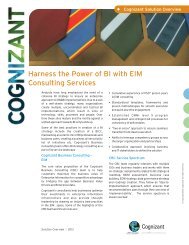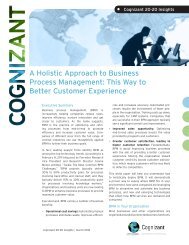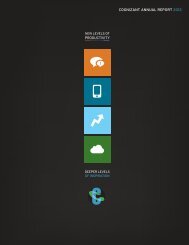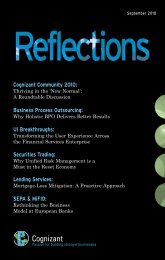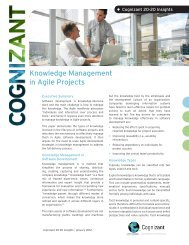DOWNLOAD "Making BYOD Work for Your Organization" - Cognizant
DOWNLOAD "Making BYOD Work for Your Organization" - Cognizant
DOWNLOAD "Making BYOD Work for Your Organization" - Cognizant
Create successful ePaper yourself
Turn your PDF publications into a flip-book with our unique Google optimized e-Paper software.
Organizations currently have only two choices when it comes to <strong>BYOD</strong> – adopt itnow or later. A transition to the <strong>BYOD</strong> model should occur in a phased manner(see Figure 8, previous page).First, organizations should analyze their return on the investment of enablingand supporting <strong>BYOD</strong>. They need to consider the costs of setting up the requiredinfrastructure, one-time investments in MDM, MAM and MADP solutions,supporting the program and reimbursements <strong>for</strong> device purchases. Looking atreturns over the long term and the possible value-additions from such a programwill be a better yardstick to measure the ROI.Second, they should examine the current infrastructure that is designed tosupport corporate-issued devices and bolster it with the additional capabilitiesrequired to support <strong>BYOD</strong> programs. Organizations should be proactiveand recommend to employees the ideal devices and plat<strong>for</strong>ms that can quicklydeliver the desired benefits. Organizations should ideally recommend preferredvendors and discounted pricing contracts <strong>for</strong> devices and apps to help minimizecosts.Lastly, a critical step is that the employee onboarding process should be smoothand simple.The Future of <strong>BYOD</strong><strong>BYOD</strong> introduces a multitude of challenges; however, organizations should treat thisas an opportunity that can yield significant benefits, both tangible and intangible.The key is to approach <strong>BYOD</strong> in a holistic fashion to address employee expectations,while ensuring business requirements are met related to security, compliance andrisk minimization. The need <strong>for</strong> agility and speed will more rapidly trans<strong>for</strong>m therole of IT from a support function to a strategic, business-enabling function.Successful organizations will take a proactive approach to embracing andmolding <strong>BYOD</strong> <strong>for</strong> competitive advantage and the agility to outmaneuver thecompetition. Creating obstacles to <strong>BYOD</strong> will be futile as empowered employeesare provisioning their own technology anyway. Younger employees and thosewith a millennial mindset find it hard to draw the line between their personal andprofessional lives and seek the flexibility and ease-of-use that their personal devicesprovide. Implemented with the right strategy, <strong>BYOD</strong> can:Empower employees to improve their productivity through their choice ofdevices and collaboration styles.Ensure security of corporate data while complying with corporate mandates oncompliance, risk management and privacy.Deliver cost savings with minimal IT support <strong>for</strong> employee-owned devices.Simplify IT by running any app, anywhere, on any device.13 FUTURE OF WORK June 2012




